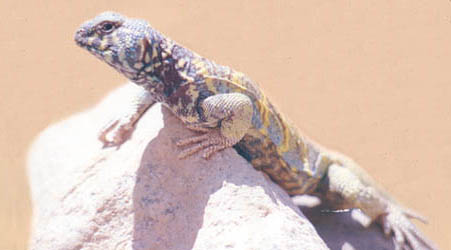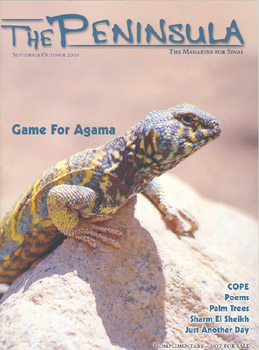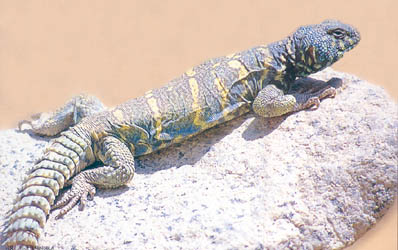However, the one’s we’re interested in locally,
scientifically known as Agama stellio vulgaris, are about 20cm long. Living mainly off
insects and spiders, with a little light salad on the side, they hide in vegetation or
under rocks waiting for their next meal to pass by. Their hapless prey first knows
it’s come to a sticky end when it gets caught on the end of the lizards mucous
covered tongue.
From there on in it’s bitten by the first set of teeth and
then crushed by the second before being swallowed.
We all know that life’s a game, and winner takes all, but the
boss of the 25 strong family groups really knows how to let us know who’s in charge.
It’s all about colour you see. The females, as usual, are at
the bottom of the social ladder. They’re a brown colour all over unless they’re
carrying eggs, in which case their head turns blue to warn off any prospective admirers.
On the next rung up are the subordinate males who are most of the time brownish with an
olive green head. At the top of the ladder is Mr. Big and there’s no doubting that
he’s different from the rest of the crowd. Not only is he bigger at 25 cm. but
he’s brighter in both senses of the word. His body is blue and he has a red or yellow
head and tail which says ‘don’t mess with me’.
 Should any lizard try to muscle in on his territory, the behavior that
follows shows remarkable similarities to that found in your local bar. It starts off with
a bit of ‘head nodding’, a precursor to some serious ‘nutting’. If the
competitor doesn’t take the hint then it gets a bit more serious and moves onto a
kind of push up where the whole of Mr.Bigs torso begins to bob up and down as he starts to
get angry and turns a darker shade. It should be obvious to all but the uninitiated by now
that it’s time to back off, but if the new boy on the block still doesn’t
retreat then Mr. Big starts to get really upset, hops around a bit, then charges across,
spins around Kung Fu style and smacks him hard with his tail. This continues in a show of
bluffs, threats and out and out combat until the best man wins. My money, however, is on
Mr.Big.
Should any lizard try to muscle in on his territory, the behavior that
follows shows remarkable similarities to that found in your local bar. It starts off with
a bit of ‘head nodding’, a precursor to some serious ‘nutting’. If the
competitor doesn’t take the hint then it gets a bit more serious and moves onto a
kind of push up where the whole of Mr.Bigs torso begins to bob up and down as he starts to
get angry and turns a darker shade. It should be obvious to all but the uninitiated by now
that it’s time to back off, but if the new boy on the block still doesn’t
retreat then Mr. Big starts to get really upset, hops around a bit, then charges across,
spins around Kung Fu style and smacks him hard with his tail. This continues in a show of
bluffs, threats and out and out combat until the best man wins. My money, however, is on
Mr.Big.
 Should any lizard try to muscle in on his territory, the behavior that
follows shows remarkable similarities to that found in your local bar. It starts off with
a bit of ‘head nodding’, a precursor to some serious ‘nutting’. If the
competitor doesn’t take the hint then it gets a bit more serious and moves onto a
kind of push up where the whole of Mr.Bigs torso begins to bob up and down as he starts to
get angry and turns a darker shade. It should be obvious to all but the uninitiated by now
that it’s time to back off, but if the new boy on the block still doesn’t
retreat then Mr. Big starts to get really upset, hops around a bit, then charges across,
spins around Kung Fu style and smacks him hard with his tail. This continues in a show of
bluffs, threats and out and out combat until the best man wins. My money, however, is on
Mr.Big.
Should any lizard try to muscle in on his territory, the behavior that
follows shows remarkable similarities to that found in your local bar. It starts off with
a bit of ‘head nodding’, a precursor to some serious ‘nutting’. If the
competitor doesn’t take the hint then it gets a bit more serious and moves onto a
kind of push up where the whole of Mr.Bigs torso begins to bob up and down as he starts to
get angry and turns a darker shade. It should be obvious to all but the uninitiated by now
that it’s time to back off, but if the new boy on the block still doesn’t
retreat then Mr. Big starts to get really upset, hops around a bit, then charges across,
spins around Kung Fu style and smacks him hard with his tail. This continues in a show of
bluffs, threats and out and out combat until the best man wins. My money, however, is on
Mr.Big. Found all over the world in various
guises, the Agama lizard is a bit of a throwback when compared to its modern day Iguana
counterparts. Depending on their habitat they’ve evolved into 15 different species,
from the ‘flying dragons’ of New Guinea who can glide over 30 metres from the
tree tops on their overdeveloped rib cage ‘wings’, to the ‘water
lizards’ of the East Indies who can reach up to a metre in length and the little
‘toad heads’ who are a mere 12 cm long and run around on two legs.
Found all over the world in various
guises, the Agama lizard is a bit of a throwback when compared to its modern day Iguana
counterparts. Depending on their habitat they’ve evolved into 15 different species,
from the ‘flying dragons’ of New Guinea who can glide over 30 metres from the
tree tops on their overdeveloped rib cage ‘wings’, to the ‘water
lizards’ of the East Indies who can reach up to a metre in length and the little
‘toad heads’ who are a mere 12 cm long and run around on two legs.
 Usually, half a dozen eggs are laid in a hole in damp sand and a couple of
months later they dig their way out and immediately start eating anything they can find.
If their nest was a warm one, over 29 degrees, then they’ll all be hot-blooded males.
The cooler the nest, the more Ice Maidens. After a couple of solitary months they find
themselves a group to join and start the story all over again.
Usually, half a dozen eggs are laid in a hole in damp sand and a couple of
months later they dig their way out and immediately start eating anything they can find.
If their nest was a warm one, over 29 degrees, then they’ll all be hot-blooded males.
The cooler the nest, the more Ice Maidens. After a couple of solitary months they find
themselves a group to join and start the story all over again.